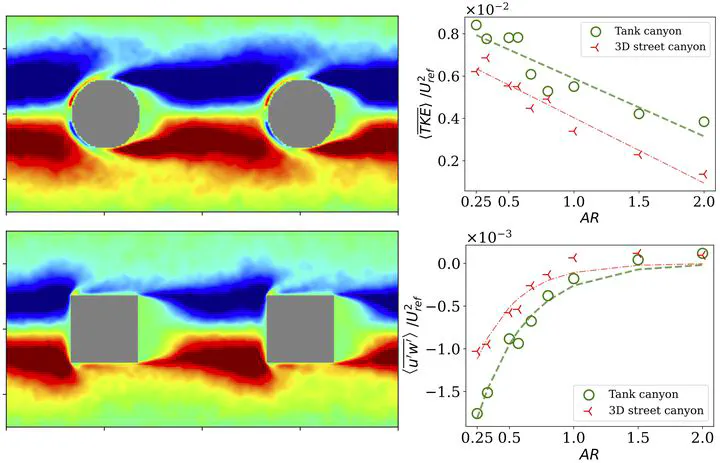Turbulent flow over aligned cylinders
 Image credit: G. DUAN
Image credit: G. DUANAbstract
Turbulent flow and boundary-layer (BL) characteristics over cylindrical obstacles have been understudied compared to the flow dynamics around cubic roughness in the urban BL literature. Using large-eddy simulation, we investigate a turbulent BL flow developed over two vertically oriented cylindrical obstacles aligned downstream. For widely separated cylinders, the wake flow undergoes periodic oscillations akin to vortex shedding behind an isolated cylinder. As the height-to-width aspect ratio (AR) of the canyon bounded by the cylinders increases, the streamline geometry exhibits a clear transition from isolated to wake interference and skimming regimes. Two-point autocorrelation functions of velocities confirm a strong coupling of canyon flow with the roughness sublayer for wider canyons, while with evident decoupling as the canyon narrows. The length scales, which measure the spatial correlation in the flow, decrease in both lateral and vertical directions with increasing AR. Turbulent kinetic energy and momentum fluxes below the roughness sublayer present pronounced monotonic scaling with AR (with R-squared values up to 0.84 and 0.98, respectively), resulting in a consistent variation in the surface roughness aerodynamic parameters, the roughness length (z0) and zero-plane displacement (d), with AR. Quantitative differences in the results with respect to those well-established for street canyons are analyzed, with the similarities highlighted. The results offer insights into boundary-layer flow parameterization concerning cylinder-occupied surface roughness.
Type
Publication
Physics of Fluids
This paper belongs to Flow and Civil Structures of Physics of Fluids.
Create your slides in Markdown - click the Slides button to check out the example.
Add the publication’s full text or supplementary notes here. You can use rich formatting such as including code, math, and images.